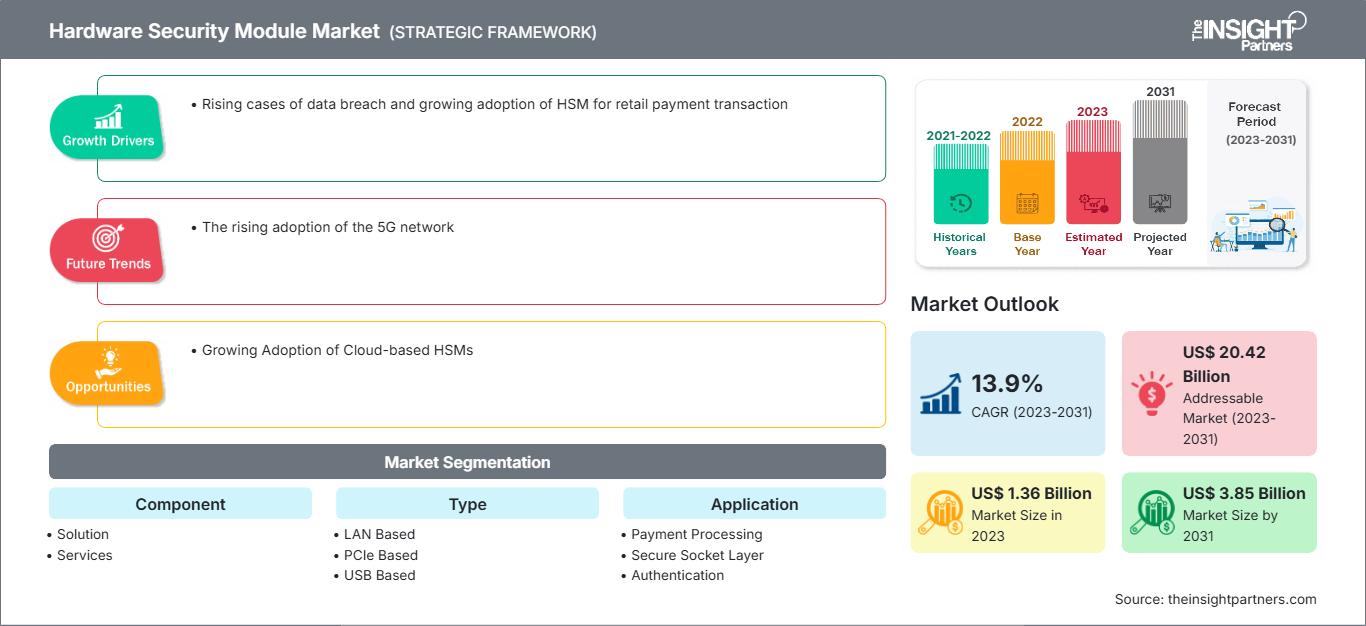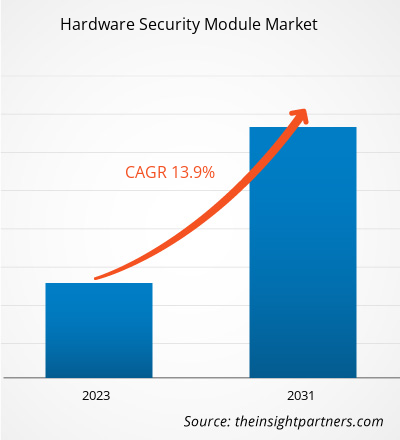Der Markt für Hardware-Sicherheitsmodule soll von 1,36 Milliarden US-Dollar im Jahr 2023 auf 3,85 Milliarden US-Dollar im Jahr 2031 anwachsen. Für den Zeitraum 2023–2031 wird ein durchschnittliches jährliches Wachstum (CAGR) von 13,9 % erwartet. Die zunehmende Verbreitung des 5G-Netzes dürfte einer der wichtigsten Trends auf dem Markt bleiben.
Marktanalyse für Hardware-Sicherheitsmodule
Viele große Unternehmen und Konzerne arbeiten mit riesigen Mengen sensibler und vertraulicher Daten. Die Nachfrage nach HSM ist als Reaktion auf den verbesserten Datenschutz infolge der zunehmenden Fälle von Cyberangriffen gestiegen. Somit treibt die Zunahme von Datenschutzverletzungen und Cyberangriffen das Wachstum des Marktes für Hardware-Sicherheitsmodule voran. Darüber hinaus wird erwartet, dass die zunehmende Verbreitung cloudbasierter HSM in den kommenden Jahren Chancen für Marktwachstum schaffen wird. HSM mit cloudbasierten Technologien bieten physischen Schutz vor Datenzugriff, Schlüsselgenerierung, sichere Verwaltung von Schlüsselmaterial und eine sichere Ausführungsumgebung für Cloud-Anwendungen.
Branchenübersicht für Hardware-Sicherheitsmodule
Ein Hardware-Sicherheitsmodul (HSM) ist ein dedizierter Kryptoprozessor, der speziell für den Lebenszyklusschutz von Kryptoschlüsseln entwickelt wurde. Hardware-Sicherheitsmodule verwalten, verarbeiten und speichern kryptografische Schlüssel sicher in einem gehärteten, manipulationssicheren Gerät und fungieren als Vertrauensanker zum Schutz der kryptografischen Infrastruktur sicherheitsbewusster Unternehmen weltweit. Sie tragen zur Risikominimierung und zur Erfüllung von Compliance-Anforderungen bei, indem sie PKI, Blockchain, Code Signing, Dokumentensignierung, Datenbankverschlüsselung, eIDAS, DSGVO, DNSSEC, PCI DSS und andere Lösungen nutzen. Darüber hinaus schützt es kryptografische Schlüssel überall dort, wo die Anwendungen und Workloads von Unternehmen im großen Maßstab ausgeführt werden, und bietet so mehr Flexibilität. Darüber hinaus schützt HSM den digitalen Wandel mit Geräten, die für moderne Rechenzentren entwickelt wurden.
Passen Sie diesen Bericht Ihren Anforderungen an
Sie erhalten kostenlos Anpassungen an jedem Bericht, einschließlich Teilen dieses Berichts oder einer Analyse auf Länderebene, eines Excel-Datenpakets sowie tolle Angebote und Rabatte für Start-ups und Universitäten.
Markt für Hardware-Sicherheitsmodule: Strategische Einblicke

-
Holen Sie sich die wichtigsten Markttrends aus diesem Bericht.Dieses KOSTENLOSE Beispiel umfasst Datenanalysen, die von Markttrends bis hin zu Schätzungen und Prognosen reichen.
Markttreiber und Chancen für Hardware-Sicherheitsmodule
Zunehmende Fälle von Datenschutzverletzungen
Viele große Unternehmen und Konzerne arbeiten mit riesigen Mengen sensibler und vertraulicher Daten. Die zunehmende Digitalisierung hat zahlreiche Unternehmen aus unterschiedlichen Branchen dazu ermutigt, ihre Abläufe zu digitalisieren, um sich Wettbewerbsvorteile zu verschaffen, betriebliche Arbeitsabläufe zu verbessern und gezieltere Zielgruppen zu erreichen. Die Einführung digitaler Lösungen macht jedoch kritische Daten angreifbar und für Hacker zugänglich, was unter anderem zum Verlust wichtiger Informationen, finanziellen Einbußen und Vertrauensverlust der Kunden führen kann. Die steigende Zahl von Datenschutzverletzungen beeinträchtigt die allgemeine Geschäftsentwicklung. Im Folgenden werden einige der Fälle von Datenschutzverletzungen genannt:
- Im Juni 2023 lud ein Telegram-Bot die Daten von Personen hoch, die sich in der COWIN-App in Indien registriert hatten, was zu einer massiven Datenschutzverletzung führte. Das Datenleck umfasste Mobiltelefonnummern, Aadhar-Karten-IDs, Reisepässe und andere wichtige Kundeninformationen.
- Im Juli 2023 veröffentlichte IBM Security den Bericht „Cost of a Data Breach“ für 2023. Der Bericht zeigte, dass die weltweiten durchschnittlichen Kosten eines Datenlecks im Jahr 2023 4,45 Millionen US-Dollar erreichten, was einem Anstieg von 15 % gegenüber den letzten drei Jahren entspricht.
- Im Juli 2023 wurde das Dateiübertragungstool MOVEit Opfer eines massiven Datenhacks, der 200 Organisationen und 17,5 Millionen Einzelpersonen betraf. Die Daten mehrerer wichtiger Organisationen und Regierungsbehörden, wie dem Landwirtschaftsministerium, dem Energieministerium und dem Gesundheitsministerium, sind durchgesickert.
- Im Mai 2023 kam es bei T-Mobile, der Marke der Deutschen Telekom AG, zum zweiten Mal im Jahr 2023 zu einem Datenleck. Dabei wurden die PINs, vollständigen Namen und Telefonnummern von über 800 Kunden geleakt.
Um Daten zu schützen und ihre Netzwerksicherheit zu erhöhen, verwenden Unternehmen Hardware-Sicherheitsmodul-Lösungen (HSM). Die steigende Zahl von Datenlecks führt somit zu einer Nachfrage nach verbesserten Sicherheitslösungen wie Hardware-Sicherheitsmodulen, was den Markt für Hardware-Sicherheitsmodule antreibt.
Zunehmende Nutzung von Cloud-basierten HSMs
HSMs mit Cloud-basierten Technologien bieten physischen Schutz vor Datenzugriff, Schlüsselgenerierung, sichere Verwaltung von Schlüsselmaterial und eine sichere Ausführungsumgebung für Cloud-Anwendungen. Einige der wichtigsten Marktteilnehmer konzentrieren sich auf die Entwicklung fortschrittlicher Hardware-Sicherheitsmodule für Cloud-basierte Anwendungen. So stellte Marvell im September 2022 seinen Hardware-Sicherheitsmoduladapter LiquidSecurity 2 (LS2) vor, eine fortschrittliche Lösung, die Verschlüsselung, Schlüsselverwaltung, Authentifizierung und weitere Hardware-Sicherheitsmoduldienste in der Cloud bietet. Darüber hinaus ist LS2 eine konvergente Sicherheitsplattform für Zahlungen, Datenschutzkonformität und allgemeine Anwendungen. Sie basiert auf Marvell OCTEON, einer Cloud-optimierten Datenverarbeitungseinheit (DPU), die sich weltweit als größte Hyperscale-Cloud bewährt hat. Der neue Adapter bietet leistungsstärkste kryptografische Beschleunigung und Verarbeitung sowie hardwaregesicherten Speicher für bis zu eine Million Schlüssel für AES-, RSA- und ECC-Verschlüsselungsalgorithmen und 45 Partitionen für robuste Multi-Tenant-Anwendungsfälle. Im August 2023 kündigte Thales außerdem die Einführung seines neuen payShield Cloud HSM-Dienstes an, der die Einführung von Cloud-Zahlungsinfrastrukturen fördern soll. Die Lösung, die auf dem payShield 10k Payment Hardware Security Module (HSM) basiert, konzentriert sich darauf, Kunden verbesserte Flexibilität, Skalierbarkeit und schnellere Markteinführung zu bieten. Daher wird erwartet, dass die zunehmende Verbreitung cloudbasierter HSMs im Prognosezeitraum lukrative Möglichkeiten für das Wachstum des Marktes für Hardware-Sicherheitsmodule schaffen wird.
Segmentierungsanalyse des Marktberichts für Hardware-Sicherheitsmodule
Schlüsselsegmente, die zur Ableitung der Marktanalyse für Hardware-Sicherheitsmodule beigetragen haben, sind Typ, Anwendung und Branche.
- Basierend auf dem Typ ist der Markt in LAN-basiert, PCIe-basiert und USB-basiert unterteilt. Das LAN-basierte Segment hatte 2022 den größten Marktanteil bei Hardware-Sicherheitsmodulen; es wird jedoch erwartet, dass das PCIe-basierte Segment zwischen 2022 und 2030 die höchste durchschnittliche jährliche Wachstumsrate verzeichnet.
- In Bezug auf die Anwendung ist der Markt in Zahlungsabwicklung, Secure Socket Layer, Authentifizierung, Code- und Dokumentensignatur, Datenbankverschlüsselung, Anmeldeinformationsverwaltung und Verschlüsselung auf Anwendungsebene unterteilt. Das Segment Zahlungsabwicklung hielt 2023 den größten Anteil am Markt für Hardware-Sicherheitsmodule.
- Nach Branchen ist der Markt in BFSI, Regierung, IT & Telekommunikation, Gesundheitswesen, Fertigung, Einzelhandel & Konsumgüter und Sonstiges unterteilt. Das BFSI-Segment hielt 2023 den größten Anteil am Markt für Hardware-Sicherheitsmodule.
Marktanteilsanalyse für Hardware-Sicherheitsmodule nach Region
Der geografische Umfang des Marktberichts für Hardware-Sicherheitsmodule ist hauptsächlich in fünf Regionen unterteilt: Nordamerika, Asien-Pazifik, Europa, Naher Osten & Afrika sowie Süd- & Mittelamerika.
Europa hielt 2022 den größten Marktanteil für Hardware-Sicherheitsmodule. Der europäische Markt wird im Prognosezeitraum voraussichtlich wachsen, da das Bewusstsein für die Vorteile von HSMs in Bezug auf die Datensicherheit steigt. Die wachsenden Branchen BFSI, IT & Telekommunikation, Gesundheitswesen und andere in der Region erhöhen den Bedarf an Hardware-Sicherheitsmodulen zum Schutz ihrer Geschäftsinformationen. Darüber hinaus schaffen die zunehmenden digitalen Fortschritte in Deutschland, Großbritannien und anderen europäischen Ländern sowie die zunehmende Verbreitung von Cloud-basierten HSMs eine Chance für das Wachstum des Marktes für Hardware-Sicherheitsmodule in Europa.
Hardware-Sicherheitsmodul
Regionale Einblicke in den Markt für Hardware-Sicherheitsmodule
Die Analysten von The Insight Partners haben die regionalen Trends und Faktoren, die den Markt für Hardware-Sicherheitsmodule im Prognosezeitraum beeinflussen, ausführlich erläutert. In diesem Abschnitt werden auch die Marktsegmente und die geografische Lage von Hardware-Sicherheitsmodulen in Nordamerika, Europa, Asien-Pazifik, dem Nahen Osten und Afrika sowie Süd- und Mittelamerika erörtert.
Umfang des Marktberichts zum Hardware-Sicherheitsmodul
| Berichtsattribut | Einzelheiten |
|---|---|
| Marktgröße in 2023 | US$ 1.36 Billion |
| Marktgröße nach 2031 | US$ 3.85 Billion |
| Globale CAGR (2023 - 2031) | 13.9% |
| Historische Daten | 2021-2022 |
| Prognosezeitraum | 2023-2031 |
| Abgedeckte Segmente |
By Komponente
|
| Abgedeckte Regionen und Länder |
Nordamerika
|
| Marktführer und wichtige Unternehmensprofile |
|
Dichte der Marktteilnehmer für Hardware-Sicherheitsmodule: Auswirkungen auf die Geschäftsdynamik verstehen
Der Markt für Hardware-Sicherheitsmodule wächst rasant. Dies wird durch die steigende Endverbrauchernachfrage aufgrund veränderter Verbraucherpräferenzen, technologischer Fortschritte und eines stärkeren Bewusstseins für die Produktvorteile vorangetrieben. Mit der steigenden Nachfrage erweitern Unternehmen ihr Angebot, entwickeln Innovationen, um den Bedürfnissen der Verbraucher gerecht zu werden, und nutzen neue Trends, was das Marktwachstum weiter ankurbelt.

- Holen Sie sich die Markt für Hardware-Sicherheitsmodule Übersicht der wichtigsten Akteure
Neuigkeiten und aktuelle Entwicklungen zum Markt für Hardware-Sicherheitsmodule
Der Markt für Hardware-Sicherheitsmodule wurde durch die Erhebung qualitativer und quantitativer Daten nach Primär- und Sekundärforschung bewertet, darunter wichtige Unternehmenspublikationen, Verbandsdaten und Datenbanken. Einige der Entwicklungen auf dem Markt für Hardware-Sicherheitsmodule sind unten aufgeführt:
- Thales Trusted Cyber Technologies (TCT) hat die Einführung der neuen Version 7.13.0 der Luna Network- und PCIe-HSMs angekündigt. Sie umfasst verschiedene Funktionen wie die Remote-Initialisierung des Remote PED Vector Key, wodurch eine vollständig Remote-HSM-Verwaltung ermöglicht wird, Unterstützung für das LACP 802.3ad-Protokoll zur Verbesserung der Multi-NIC-Port-Bonding in der Network HSM-Appliance sowie Luna-Client-Unterstützung für Windows Server 2022 und Ubuntu 22 LTS. (Quelle: HDI Global, Pressemitteilung, Juni 2023)
Bericht zum Markt für Hardware-Sicherheitsmodule – Abdeckung & Lieferumfang
Der Marktbericht „Marktgröße und Prognose für Hardware-Sicherheitsmodule (2021–2031)“ bietet eine detaillierte Analyse des Marktes und deckt die folgenden Bereiche ab:
- Marktgröße und Prognose für Hardware-Sicherheitsmodule auf globaler, regionaler und Länderebene für alle abgedeckten wichtigen Marktsegmente
- Markttrends für Hardware-Sicherheitsmodule sowie Marktdynamik wie Treiber, Einschränkungen und wichtige Chancen
- Detaillierte PEST/Porters Five Forces- und SWOT-Analyse
- Marktanalyse für Hardware-Sicherheitsmodule mit wichtigen Markttrends, globalen und regionalen Rahmenbedingungen, wichtigen Akteuren, Vorschriften und aktuellen Marktentwicklungen
- Branchenlandschaft und Wettbewerbsanalyse mit Marktkonzentration, Heatmap-Analyse, prominenten Akteuren und aktuellen Entwicklungen auf dem Markt für Hardware-Sicherheitsmodule
- Detaillierte Unternehmensprofile.
- Historische Analyse (2 Jahre), Basisjahr, Prognose (7 Jahre) mit CAGR
- PEST- und SWOT-Analyse
- Marktgröße Wert/Volumen – Global, Regional, Land
- Branchen- und Wettbewerbslandschaft
- Excel-Datensatz
Aktuelle Berichte
Verwandte Berichte
Erfahrungsberichte
Grund zum Kauf
- Fundierte Entscheidungsfindung
- Marktdynamik verstehen
- Wettbewerbsanalyse
- Kundeneinblicke
- Marktprognosen
- Risikominimierung
- Strategische Planung
- Investitionsbegründung
- Identifizierung neuer Märkte
- Verbesserung von Marketingstrategien
- Steigerung der Betriebseffizienz
- Anpassung an regulatorische Trends






















 Kostenlose Probe anfordern für - Markt für Hardware-Sicherheitsmodule
Kostenlose Probe anfordern für - Markt für Hardware-Sicherheitsmodule